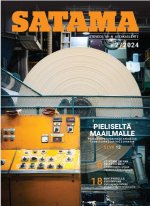Hundred-metre snow-devouring giant

When there are record piles of snow in front of a locomotive on the track, a hundred-metre-long device made in Russia called the “Snow Eater” train, rushes to the scene.
The Snow Eater (SM-7) is new railway winter maintenance equipment that was tested in eastern and northern Finland last February.
“The purpose of this Finnish Transport Infrastructure Agency project was to study how the Russian SM-7 is suited to Finnish conditions when a surprise snow condition arises,” says Evgeny Lindström, Sales Manager at Teräspyörä, the company that brought the Snow Eater to Finland.
Testing passes muster
The device came to Finland from Tosno in the St Petersburg area where there is a large Russian railway workshop that manages and maintains all rolling stock for the entire St Petersburg area. The Finnish Transport Infrastructure Agency and rail operator VR have a long history of cooperation with the Russian railways: the Finnish-Russian railway connection goes back 150 years. Cooperation is also facilitated by the fact that both countries have nearly the same track gauge of 1520/1524 millimetres, which differs from the 1435 millimetres commonly used in Europe.
Teräspyörä acted as a consultant and trainer in the project.
“I conducted several training sessions with the Snow Eater staff on Finnish occupational safety and track safety. The Transport Infrastructure Agency also tasked us with handling all the practicalities related to the import of the device,” says Lindström.
Teräspyörä’s responsibilities also included technical consulting on matters related to the functionality of the machine, translation of documentation, brake calculations and advising on technical issues.
The Snow Eater arrived in Vainikkala on 17 February 2020, from where it was towed to the non-electrified section of the Railway Technical Learning Centre in the city of Kouvola. Teräspyörä equipped it with the protective equipment needed for the Finnish conditions there. The journey continued to Kontiomäki, where tests were carried out on straight rail sections. Further tests were then conducted at the Kemi and Tornio railway yards. The Snow Eater left Finland via Vainikkala on 2 March.
Steveco to the rescue
To Lindström's surprise, no one was willing to help Teräspyörä import the device until he contacted Steveco.
“I got exceptionally good and friendly service from Steveco from the beginning. Everything went smoothly. Both import and export documents were handled really well at all stages.”
“On behalf of the importer, we were responsible for preparing the customs documents for the temporary import and re-export of the train. For this, we needed a temporary import permit application from Teräspyörä,” Saija Malm, freight forwarder at Steveco, recalls.
Temporary importation means that the device will be allowed to operate in Finland for a certain period and must leave the country by the deadline.
“When the train entered the country, a temporary importation declaration was submitted. The Customs data system retains information about the expiry date of the temporary permit. If a re-export declaration has not been made by that date, Finnish Customs will contact you and inquire about it,” says Malm.
Importing and exporting the device was easy thanks to the cooperation with Steveco.
“Because we and Steveco had planned the import in detail, the Transport Infrastructure Agency had no problems with the device other than the lack of snow in southern Finland,” says Lindström.
Papers prepared without a hitch
Teräspyörä contacted Steveco a couple of months before the import.
“We worked with Steveco to find out what documents the import requires. I asked the Russian railways for the necessary documents. Even though it was a huge device, it was easy to import without any bureaucratic and red tape problems,” says Lindström.
“What I especially remember about the project are the good organisational skills of Steveco throughout the project. Everything worked without a single hitch. Collaboration between Steveco, Finnish Customs and the Border Guard was professional and safe at all times, which is important in an international project.”
Malm also recalls the cooperation as a pleasant experience.
“I got all the necessary advance information about the device from Teräspyörä in good time. When we knew what additional information we needed, we got it from them quickly. For example, for a temporary import permit we needed information about the purpose and place of operation of the device. Although it was a very exceptional device, the related documents were standard import documents.”
About Author

Satama
SATAMA is our customer magazine. it is published twice a year in Finnish.
